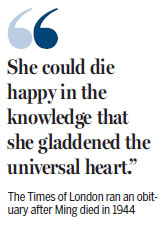
|
Ming the panda gets behind the camera for photographer Bert Hardy in 1939 in London Zoo. In the chair is Hardy's son Mike. Getty Image |
She was black, white and furry, far from home, and loved having her tummy tickled, especially by princesses.
Now Ming, the giant panda who brought so much joy to Londoners, especially children, during the dark days of the German blitzkrieg during the World War II, will be remembered with a statue erected in her honor at London Zoo, where she spent much of her time from 1938 to 1944.
Ming was born in Sichuan province in 1937. At the time, less emphasis was placed on panda preservation, and she was captured by hunters and eventually given to Floyd Tangier-Smith, an American banker and adventurer who was in the region.
She and five others were to be sent to European zoos, but their journey was, to put it mildly, eventful. At the time, the Chinese were fighting Japanese invaders, so Tangier-Smith decided to avoid the obvious route down the Yangtze River to Shanghai and instead embarked on a dangerous journey overland to Hong Kong.
He wrote that the pandas were put in cages and loaded onto the backs of trucks for the journey to Hong Kong "on roads that were often nearly impassable through bandit-infested country". One truck overturned and two of the pandas enjoyed temporary freedom until they were recaptured.
When the pandas were being loaded onto a ship in Hong Kong bound for London, one of the six was found dead.
The survivors, known to their captors as Grandma, Happy, Dopey and Grumpy, along with the cub who would become known as Ming, were put into cages and lifted onto the deck of a cargo ship. They arrived in London at the height of a raging blizzard, according to a Daily Mail report at the time.
Grandma, the eldest, caught pneumonia and died two weeks after arriving in Great Britain, while Happy was acquired by a German zoo owner.
The Zoological Society of London, which runs London Zoo in Regent's Park and Whipsnade Zoo in the Bed-fordshire countryside, took over the care of Ming and her older siblings, Sung and Tang. All three were named for Chinese dynasties.
Ming was the first giant panda cub to come to Britain and created massive interest. Her image was reproduced in cartoons and picture postcards; soft toys were made; and her story appeared in newspapers, magazines and on the fledgling television broadcasts from London's Alexandra Palace.
Bert Hardy, one of Britain's best-known photographers, managed to capture a moment showing a playful Ming behind one ofhis cameras ona tripod, seemingly taking a picture of his son, Mike. The photograph went around the world.
After Britain declared war on Germany in September 1939, visits to see Ming became a reminder of normality and a morale booster for British children.
Chinese poet and author Chiang Yee, who was living in London, visited the zoo and wrote about the crowds flocking to see Ming, who had rapidly become a celebrity.
"There were rows and rows of them, especially children, round her house, wanting to shake hands with her and to cuddle her," he wrote in an illustrated book, The Story of Ming.
Among those youngsters were a couple of royal children: Princess Elizabeth, who would become the Queen, and her younger sister Princess Margaret. Press reports at the time showed the royal children being escorted inside Ming's compound and tickling the panda's tummy.
Sung died in 1939, followed by Tang in the spring of 1940. At the outbreak of the war, Ming was evacuated to Whipsnade Zoo but made repeated return trips.
Ming survived most of the war. Toward the end of her life, her hair began to fall out. She died of unexplained causes at the end of 1944. It would be an understatement to say the nation mourned her loss.
The Times of London ran an obituary, virtually unheard of at a time when only the deaths of the prominent appeared on its pages. It read: "She could die happy in the knowledge that she gladdened the universal heart and even in the stress of war her death should not go unnoticed."

Ming was a pioneer in a way. The first giant panda cub to come to Britain, she unwittingly became the spearhead of what later became known as panda diplomacy.
Between 1958 and 1982, China presented 23 giant pandas as gifts to nine countries as a means of establishing friendly relations. Included among them were Ling Ling and Hsing Hsing, a pair given to the United States after President Richard Nixon's ground-breaking trip to China in 1972 that led to the normalization of relations between the two powers.
Britain also got in on the act. Former prime minister Edward Heath requested two pandas during a trip to Beijing in 1974 and Chia Chia and Ching Ching duly took up residence in London.
By 1984, things had changed and pandas became the subject of a loan program. Recipient zoos paid as much as $1 million a year for 10 years with the proviso that any cubs born were the property of China.
Recently Tian Tian, Edinburgh Zoo's resident female panda, was thought to be pregnant after her third round of artificial insemination, but in August the zoo said it was believed she had lost the cub.
Sichuan is the home of the panda, and conservation efforts there are a success story. Last year, the World Wildlife Fund for Nature said there were an estimated 1,864 pandas living in the bamboo-strewn mountains of Sichuan, Shaanxi and Gansu provinces. A further 300 live in breeding centers and zoos, mainly in China.
The people of Sichuan, proud of the panda and its links to the rest of the world, are donating a life-size statue of Ming to London Zoo to mark the 70th anniversary of the end of the World War II.
chris@mail.chinadailyuk.com